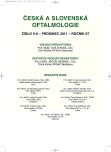AquaLase Method – Influence to the Secondary Cataract Appearance and its Safety
Authors:
M. Kalfeřtová; M. Burova; N. Jirásková; J. Nekolová; P. Rozsíval
Authors‘ workplace:
Oční klinika Lékařské fakulty Univerzity Karlovy a Fakultní nemocnice, Hradec Králové, přednosta prof. MUDr. Pavel Rozsíval, CSc., FEBO
Published in:
Čes. a slov. Oftal., 67, 2011, No. 5-6, p. 150-153
Category:
Original Article
Overview
Purpose:
To study effect of AquaLase method used for final management of posterior capsule during cataract surgery on the posterior capsule opacification (PCO) and to verify safety of this method for the eye tissue.
Methods:
The prospective clinical study involving 50 patients (100 eyes) with bilateral cataract having lens removal at the Department of Ophthalmology, University Hospital Hradec Králové in the period from September 2007 to March 2009. During the surgery was lens removed using torsional phacoemulsification and bimanual irrigation/aspiration. Cleaning of the posterior capsule of the right eye was performed using AquaLase method. All patients were examined pre-operatively and 3, 6 and 12 months after surgery. Each examination covered best corrected visual acuity (BCVA), endothelial cell count (ECC), corneal pachymetry and digital retroillumination photographs of the anterior segment focused on the posterior capsule were obtained. The Evaluation of Posterior Capsule Opacification (EPCO 2000) software and the Open-Access Systematic Capsule Assessment (OSCA) system were used for PCO evaluation.
Results:
BCVA was 0.8 in all patients. Average value for PCO index was in 3, 6 and 12 months postoperatively for right eye 0.260 ± 0.198; 0.259 ± 0.173; 0.308 ± 0.191; for left eye 0.279 ± 0.170; 0.280 ± 0.153; 0.333 ± 0.197. Average value for OSCA score was for right eye 0.599 ± 0.240; 0.605 ± 0.333; 0.598 ± 0.256; for left eye 0.627 ± 0.403; 0.635 ± 0.357; 0.541 ± 0.328. Nd-YAG capsulotomy was performed in one right eye one year after surgery.
Pachymetry and ECC results show that the method AquaLase is safe for corneal endothelium.
Conclusion:
One year after surgery, most cases of PCO were graded as minimal by both software’s of analysis. The results were not statistically significant. Pachymetry and ECC results show that the AquaLase method is safe for corneal endothelium.
Key words:
posterior capsule opacification, AquaLase method, software EPCO 2000, OSCA
Sources
1. Apple, DJ., Salomon, KD., Tetz, MR., et al.: Posterior capsular opacification, Surv. Ophtalmol. 1992; 32: 73–115.
2. Aslam, TM., Patton, N., Rose, ChJ.: OSCA: a comprehensive open-access system of analysis of posterior capsular opacification, BMC Oftalmol. 2006; 23: 30.
3. Barman, AS., Hollick, JE., Boyce, FJ., et al.: Quantification of posterior capsular opacification in digital images after cataract surgery, IOVS, 2000; 41, 12: 3882–3892.
4. Camparini, M., Macaluso, C., Reggiani, L., et al.: Retroillumination versus Reflected-Light Images in the photographic assessment of posterior capsule opacification, Investigative Ophthalmology and Visual Science, 2000; 41: 3074–3079.
5. Hu, V., Hughes, EH., Patel, N., et al.: The effect of aqualase and phacoemulsification on the corneal endothelium, Cornea, 2010; 29, 3: 247–50.
6. Jirásková, N., Kadlecová, J., Rozsíval, P., et al.: Comparison of the effect of AquaLase and NeoSonix phacoemulsification on the corneal endothelium, J Cataract Refract Surgery, 2008; 34: 377–382.
7. Jiraskova, N., Rozsival, P., Kadlecova, J., et al.: AquaLase VERSUS NeoSoniX – a comparison study, Biomed Pap Med Fac Univ Palacky Olomouc, 151, 2007, 2: 311–314.
8. Jirásková, N., Rozsíval, P., Ludvíková, M., et al.: Vliv AquaLase na rohovkové endoteliální buňky, Čes. a slov. Oftalmol. 2009; 65, 4: 139–142.
9. Jirásková, N., Rozsíval, P.: Metody hodnocení zkalení zadního pouzdra po operaci katarakty, Čes. a slov. Oftalmol. 2006; 60, 2: 155–157.
10. Nekolova, J., Jiraskova, N., Pozlerova, J., et al.: Three-year follow-up of posterior capsule opacification after AquaLase and NeoSoniX phacoemulsification, Am J Ophtalmol, 148, 2009, 3: 390–395.
11. Nekolová, J., Pozlerová, J., Jirásková, N., et al.: Opacity zadního pouzdra u pacientů s diabetes mellitus 2. typu. Čes. a slov. Oftalmol. 2008; 64: 193–196.
12. Pozlerová, J., Nekolová, J., Jirásková, N., et al.: Hodnocení opacit zadního pouzdra u různých typů umělých nitroočních čoček, Čes a Slov Oftalmol. 2009; 65: 1: 12–15.
13. Spalton, JD.: Posterior capsular opacification after cataract surgery, Eye, 1999; 13: 489–492.
14. Sundelin, K., Lundström, M., Stenevi, U.: Posterior capsule opacification: comparison between morphology, visual acuity and self – assessed visual function, Acta Ophtalmologica Scandinavica, 2006; 84, 5: 667–673.
15. Tetz, MR., Auffarth, GU., Sperker, M., et al.: Photographic image analysis system of posterior capsule opacification, J Cataract Refract Surg. 1997; 23: 1515–1520.
Labels
OphthalmologyArticle was published in
Czech and Slovak Ophthalmology

2011 Issue 5-6
Most read in this issue
- Comparison of Keratometric Values and Corneal Eccentricity of Myopia, Hyperopia and Emmetropia
- Minimal Ocular Findings in a Patient with Best Disease Caused by the c.653G>A Mutation in BEST1
- AquaLase Method – Influence to the Secondary Cataract Appearance and its Safety
- Suprachoroid Hemorrhage without the Connection to the Surgical Procedure
